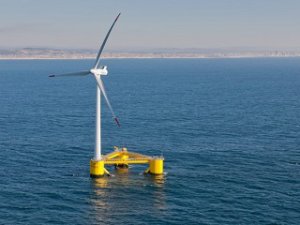Wind Is a Big Deal

From Bullish on Renewable Energy: Within the offshore wind industry, there is an emerging subsection of floating wind turbines. With fixed offshore wind turbines, there is a limit to viable water depth which limits suitable sites to areas with water depth up to around 30 meters. Floating designs allow deeper waters to be exploited, greatly increasing the number of potential sites for offshore wind power, and allowing the turbines to be placed further out to sea in areas with better wind resources. With further R&D and volume production, it is likely that floating wind farms can match, or possibly even better the costs of fixed offshore wind power.
Benefits include no visual pollution and no interference with shipping lanes.
Good news all around.

Craig,
One of the problems with reading only press releases from Wind technology corporations, is they naturally emphasis only the positives.
Since you are a Wind power advocate and enthusiast I can understand you would think this is good news.
However, perhaps if you did a little more objective research you many become a little less enthusiastic and more apprehensive.
Could you be a little bit less specific? That way I won’t know what you’re referring to at all.
Craig,
Frustrating isn’t it ? When I am more specific, you either ignore carefully detailed references, tell me to ” look something up, or dismiss all supporting evidence without explanation.
So I thought this was a style you preferred.
Like US Ethanol production, the deficiencies of Wind Power haven’t been subjected to proper analysis. The enormous wave of enthusiasm and huge corporate investment (all government guaranteed) arose as a result of a political and ideological desire to create “renewable energy”.
But are large scale floating Wind Turbines the best way forward ? Are they the best use of taxpayer-consumer funds? Are we helping huge corporations create another Ethanol ?
Typical of the publicity material for floating wind turbines is from Statoils press release : ” The $US63 Million 20mw Turbine will produce enough electricity to power 1300 homes” .
Sounds great! But how accurate ? Well, it’s completely accurate if you simply multiply 20mw by 24 hours 350 day per year and divide that by the estimated use of 1300 mythical homes somewhere in the country the turbine is located.
Then to get the cost per hour to each home, we simply divide 20mw by 1300 and we have the cost of power production. This is then quoted and re-quoted by thousands of enthusiastic renewable energy fans, until it becomes an accepted truth.
But reality is very different.
Have you ever noticed how offshore advocates never mention the cost, losses and vulnerability of the distribution infrastructure ? Why ? Because the infrastructure cost is usually paid for by government agencies, and hidden in other budgets. The insurance is also provided (or underwritten) by governments.
Nor does Statoil’s optimistic calculation consider turbine down time due to storms, maintenance, damage to infrastructure, low wind strength etc.
Environmental problems to marine environments from large metal floating islands, accidents, breaking free and presenting a danger to shipping, floating semi-submerged, torn cabling etc, etc.
No calculations are mentioned for back up generation, (usually coal)(Germany is back up to nearly 40% coal), cost of maintenance, usually performed from diesel powered vessels. etc.
I could also point out the shorter than estimated life expectancy of these turbines etc, but what’s the point ?
You are sold on Wind power, and determinedly ignore,disparage or refuse to discuss any negatives. Your partisan attitude deters any discussion.
Having doubts about the viability of a particular technology in any given application, doesn’t make the doubter a “climate denier” “heretic” or even opposed to renewable energy.
It’s simply a matter of thinking the whole proposal through and asking awkward questions.
I don’t disagree with this, and your analogy to corn ethanol is a good one; it’s a great example of good intentions gone wrong. a) most people were convinced at the time that energy independence was important, b) no one seriously considered the negative environmental consequences of ethanol, c) government put a subsidy into place, d) the corn industry got addicted to it, e) we subsequently learned of the horrific environmental side-effects, but by then, f) our agricultural economy had gotten addicted to the subsidy and so g) the ag lobbies made it impossible to get rid of something that was obviously causing far more harm than good.
It’s possible that the same could exist in wind, but it’s unclear how that could be the case.
Wind is a big deal. Yes, I totally agree with you. Thanks for sharing.
I quite agree with you. Wind is a kind of source energy.